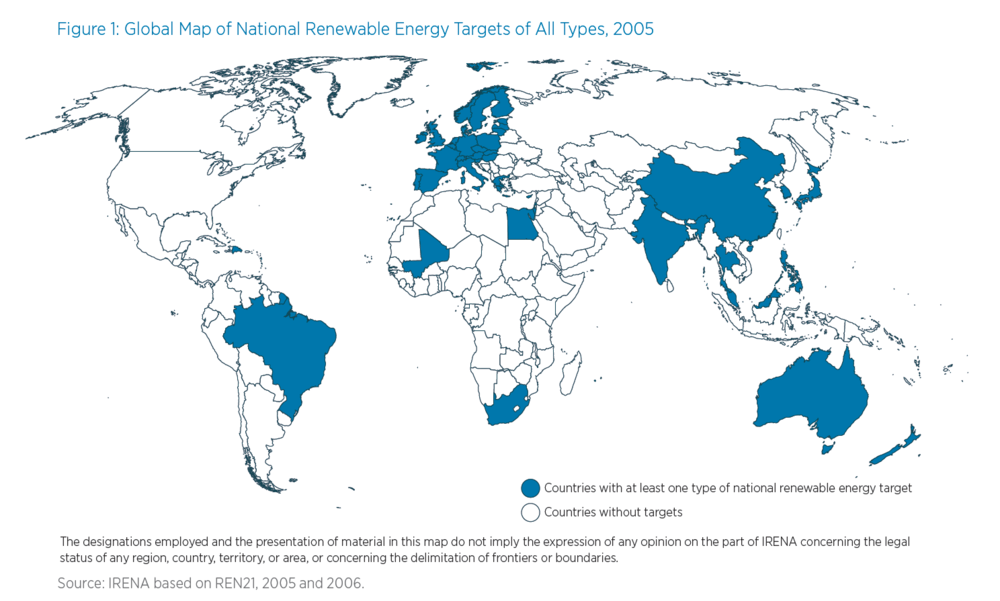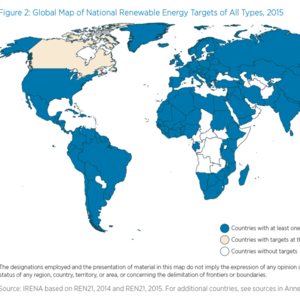Renewable energy targets quadrupled globally since 2005



June 10, 2015
BY The International Renewable Energy Agency
Renewable energy targets are now a defining feature of the global energy landscape, according to a new report by the International Renewable Energy Agency. Renewable Energy Target Setting, launched on the side lines of IRENA’s ninth Council meeting, finds that 164 countries have adopted at least one type of renewable energy target, up from just 43 countries in 2005. Two more countries, Canada and the United Arab Emirates, have set renewable energy targets at the sub-national level.
“Renewable energy targets have emerged as a popular mechanism to set national and regional economies on the path towards a more secure and sustainable energy future,” said IRENA Director-General Adnan Z. Amin. “They provide an important signal to the industry and can help to align stakeholders by creating a clearer, common vision for the development of the energy sector.”
Advertisement
Advertisement
Developing and emerging economies are leading the adoption of targets, accounting for 131 of the 164 countries with renewable energy targets. The majority of countries focus on the electricity sector—150 countries have renewable electricity targets—but commitments in other sectors are also on the rise. The number of countries setting targets for the heating/cooling sector increased from two countries in 2005 to 47 today. Similarly, renewable transport targets have more than doubled from 27 countries in 2005 to 59 today.
“Governments are increasingly adopting renewable energy targets to meet multiple objectives including energy security, environmental sustainability and socio-economic benefits,” said Mr. Amin. “The rapid growth of targets is just one more signal of the world’s ongoing shift towards renewable energy and away from fossil fuels.”
While underscoring the importance of renewable energy targets, the report recognizes that they are not sufficient in and of themselves. In order to be seen as credible by investors and society and to provide a reliable trajectory for the future evolution of the energy mix, they need to be accompanied by a clear strategy and backed by specific policies and measures.
Advertisement
Advertisement
Related Stories
The U.S. EPA on July 8 hosted virtual public hearing to gather input on the agency’s recently released proposed rule to set 2026 and 2027 RFS RVOs. Members of the biofuel industry were among those to offer testimony during the event.
The USDA’s Risk Management Agency is implementing multiple changes to the Camelina pilot insurance program for the 2026 and succeeding crop years. The changes will expand coverage options and provide greater flexibility for producers.
President Trump on July 4 signed the “One Big Beautiful Bill Act.” The legislation extends and updates the 45Z credit and revives a tax credit benefiting small biodiesel producers but repeals several other bioenergy-related tax incentives.
CARB on June 27 announced amendments to the state’s LCFS regulations will take effect beginning on July 1. The amended regulations were approved by the agency in November 2024, but implementation was delayed due to regulatory clarity issues.
SAF Magazine and the Commercial Aviation Alternative Fuels Initiative announced the preliminary agenda for the North American SAF Conference and Expo, being held Sept. 22-24 at the Minneapolis Convention Center in Minneapolis, Minnesota.
Upcoming Events










